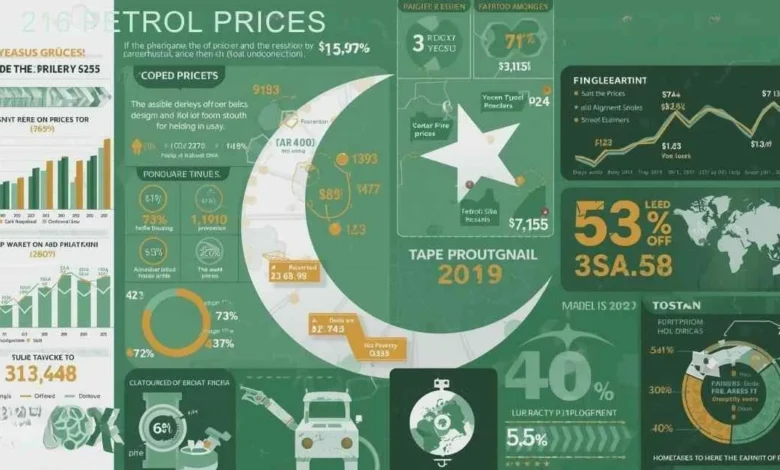An In-Depth Analysis of Petrol Prices in Pakistan: October 2025 and Beyond

Introduction: The Significance of Petrol Prices in Pakistan
In Pakistan, petrol prices are not just numbers on a fuel pump; they are an essential economic variable that impacts the purchasing power, cost of living, and transportation sector. As the world’s 5th most populous country, Pakistan’s energy consumption is growing rapidly, and its reliance on imported fuel means that petrol prices in Pakistan are highly sensitive to global oil market fluctuations.
The petrol price structure in Pakistan is intricately linked to international crude prices, currency exchange rates, taxes, and levies, alongside local factors like infrastructure costs and government policies. This article delves into the intricate details behind the petrol prices in Pakistan and highlights how various factors, including political, economic, and global elements, shape the cost at the pump.
1. Current Petrol Price Situation in Pakistan: A Snapshot of October 2025
As of October 16, 2025, Pakistan witnessed a reduction in petrol prices, continuing the pattern of bi-weekly adjustments. The new prices, which reflect the ongoing fluctuations in the global oil market, are as follows:
| Petroleum Product | Previous Price (Rs) | New Price (Rs) | Price Change (Rs) |
|---|---|---|---|
| Petrol (Motor Spirit) | 268.68 | 263.02 | -5.66 |
| High-Speed Diesel (HSD) | 276.80 | 275.41 | -1.39 |
| Superior Kerosene Oil (SKO) | 185.97 | 181.71 | -3.26 |
| Light Diesel Oil (LDO) | 165.50 | 162.76 | -2.74 |
These price adjustments are a direct result of petrol price policies in Pakistan, which aim to align domestic prices with global market conditions. The decrease in the petrol price of Rs5.66 per litre is in response to stabilizing crude oil prices and a slight appreciation of the Pakistani Rupee. This reduction offers some short-term relief to the middle and lower-income groups, but the overall impact of fuel prices on inflation and the economy continues to be significant.
2. Factors Influencing Petrol Prices in Pakistan
A. Global Oil Market Trends: The Dominant Influence
The most critical factor driving petrol prices in Pakistan is the cost of crude oil on international markets. Pakistan, like many other oil-importing countries, is directly influenced by the price fluctuations of crude oil, which is traded globally in U.S. dollars. As the world’s largest oil importers, the U.S., China, and India, continue to consume vast amounts of energy, global supply-demand imbalances have caused substantial price volatility.
Global Price Dynamics and Geopolitics
| Geopolitical Factor | Effect on Petrol Prices |
|---|---|
| OPEC Production Cuts | When OPEC (Organization of the Petroleum Exporting Countries) decides to limit production, the reduced supply globally leads to higher prices in oil-importing countries like Pakistan. |
| Geopolitical Instability | Wars or sanctions in key oil-producing countries (like Venezuela or the Middle East) can disrupt supply chains, leading to surges in petrol prices. |
| Technological Shifts | Technological advancements in shale oil extraction, particularly in the U.S., have helped stabilize global oil prices over recent years. However, the long-term effect remains uncertain as these reserves deplete. |
For example, OPEC’s decision in 2020 to cut production by 9.7 million barrels per day caused a global oil price surge, which led to an immediate rise in petrol prices in Pakistan. Similarly, geopolitical tensions in the Middle East often cause spikes in global oil prices, forcing the Pakistani government to adjust domestic prices.
B. Exchange Rate Volatility: The Ripple Effect on Petrol Prices
The exchange rate of the Pakistani Rupee (PKR) against the U.S. Dollar is another key determinant of petrol prices in Pakistan. Pakistan imports nearly all its crude oil, and since oil is priced in U.S. dollars, any depreciation of the Rupee means higher costs for petroleum products.
| Currency Impact | Effect on Petrol Prices |
|---|---|
| Rupee Depreciation | Increases the cost of imports, leading to higher petrol prices. For example, in 2018, when the PKR depreciated by over 35%, fuel prices saw a significant hike. |
| Rupee Appreciation | Reduces the cost of imports and lowers petrol prices, though this effect is often temporary and contingent on global price trends. |
The rupee’s devaluation against the U.S. dollar over the past decade has significantly contributed to the volatility of petrol prices in Pakistan, making it difficult for the government to maintain stable prices.
C. Domestic Taxation and Levy Structure
The government of Pakistan imposes several taxes and levies on petroleum products to fund various government programs. These levies and taxes constitute a significant portion of the retail price consumers pay.
- Petroleum Levy: This is a per-litre tax imposed by the government. The rate of this levy has fluctuated between Rs4-10 per litre over the years.
- General Sales Tax (GST): GST is charged on all petroleum products, and its rate has remained at around 17% in recent years.
- Climate Support Levy: This levy is imposed to support renewable energy projects and reduce carbon emissions.
| Taxation Component | Effect on Petrol Prices |
|---|---|
| Petroleum Levy | Directly increases petrol prices by adding a fixed amount to the cost per litre. |
| GST | Increases the overall price, impacting consumers, particularly those in low-income brackets. |
| Climate Levy | While promoting sustainable energy, this levy increases the upfront cost of petrol for consumers. |
These taxes make up a substantial portion of petrol prices in Pakistan, and while they provide critical government revenue, they also contribute to the overall cost burden on consumers.
3. Historical Trends and Events Impacting Petrol Prices in Pakistan
The historical trajectory of petrol prices in Pakistan reveals several phases of price surges, stabilizations, and crisis-driven adjustments. Here’s a closer look at some pivotal moments:
| Year | Price (Rs/Litre) | Key Events and Impacts |
|---|---|---|
| 2000 | 30.90 | Relatively low global oil prices and stable PKR |
| 2008 | 65.00 | Global oil price shock, financial crisis, and political instability in Pakistan |
| 2013 | 105.00 | Rising oil prices post-global financial crisis |
| 2017 | 76.50 | Government efforts to stabilize prices, fiscal adjustments |
| 2020 | 112.50 | COVID-19 pandemic impact on global supply chains and demand |
| 2025 | 263.02 | Post-pandemic economic recovery, global price surge, rupee depreciation |
For example, the sharp rise in petrol prices in Pakistan in 2008, from Rs30.90 to Rs65.00, was triggered by a combination of the global financial crisis and rising crude oil prices, reflecting a direct impact of international economic events on Pakistan’s economy.
4. Socio-Economic Impact of Petrol Prices in Pakistan
A. Inflationary Pressures
Fuel is integral to virtually every sector of the economy, from manufacturing to retail. Any significant increase in petrol prices tends to directly contribute to inflation by raising the cost of goods and services. This phenomenon is known as “cost-push inflation.”
- Transport Costs: As petrol prices in Pakistan rise, transportation costs for freight and public transport increase, causing a direct ripple effect on the cost of everyday goods.
- Consumer Prices: The cost of food, healthcare, and utilities rises as transportation costs increase, exacerbating the cost of living, especially for low-income households.
B. Impact on the Agricultural Sector
Pakistan’s agricultural sector is heavily reliant on diesel and petrol for irrigation, plowing, and the transportation of goods. A rise in petrol prices means farmers incur higher operational costs. For example, in the Sindh and Punjab provinces, where agriculture is the backbone of the economy, the price of irrigation for crops such as wheat, cotton, and rice could increase significantly.
| Agricultural Factor | Impact of Petrol Price Hike |
|---|---|
| Irrigation Costs | Higher costs for running irrigation pumps, leading to increased production costs. |
| Freight and Transport | Increased costs of transporting produce to markets, reducing farmer profitability. |
The increase in petrol prices in Pakistan often leads to higher food prices, which disproportionately affects lower-income families in rural areas.
5. Government Strategies to Stabilize Petrol Prices
A. Subsidies and Price Controls
At various times, the Pakistani government has introduced petrol subsidies to shield consumers from volatile price hikes. The government has historically stepped in with measures to control or stabilize petrol prices in Pakistan, especially during global price surges.
However, these subsidies often come at a cost, placing significant strain on the national budget. For instance, in 2020, the government subsidized fuel prices for several months during the pandemic-induced global oil price collapse.
B. Energy Diversification and Renewable Energy Initiatives
Pakistan has also begun focusing on reducing its dependency on imported oil by investing in renewable energy. Pakistan’s alternative energy development plans, such as wind, solar, and hydropower projects, aim to lessen the financial burden of global oil price fluctuations.
| Renewable Energy Initiative | Effect on Petrol Prices |
|---|---|
| Wind Energy Projects | Reduces dependency on oil imports and provides alternative energy sources, thereby potentially stabilizing petrol prices in Pakistan. |
| Solar Energy | With solar energy’s rapid adoption, the reliance on oil for power generation and transportation could reduce, easing pressure on fuel prices. |
6. Looking Ahead: The Future of Petrol Prices in Pakistan
As petrol prices in Pakistan are primarily dictated by global events and domestic policies, the future trajectory depends on a range of evolving factors:
- Global Oil Price Dynamics: Ongoing fluctuations in global oil supply, geopolitical tensions, and shifting energy markets will continue to influence prices.
- Government Energy Policies: Pakistan’s efforts to diversify its energy mix, including increased reliance on renewable energy and natural gas, could help stabilize petrol prices in the long run.
- Currency Stability: If the Pakistani Rupee strengthens against the dollar, it could help mitigate some of the price pressures from international oil imports.
Conclusion
The analysis of petrol prices in Pakistan reveals the deep interconnections between global economic factors, local fiscal policies, and the daily lives of ordinary Pakistanis. The government’s role in regulating and stabilizing petrol prices is vital, but the future of petrol prices in Pakistan will ultimately depend on global oil markets, domestic energy policies, and the resilience of the Pakistani Rupee.
In summary, while petrol price changes in Pakistan provide temporary relief to consumers, long-term stability will require sustained efforts towards energy diversification, fiscal responsibility, and adapting to global market trends.
References
- Dawn News
- Profit Pakistan Today
- The Express Tribune

